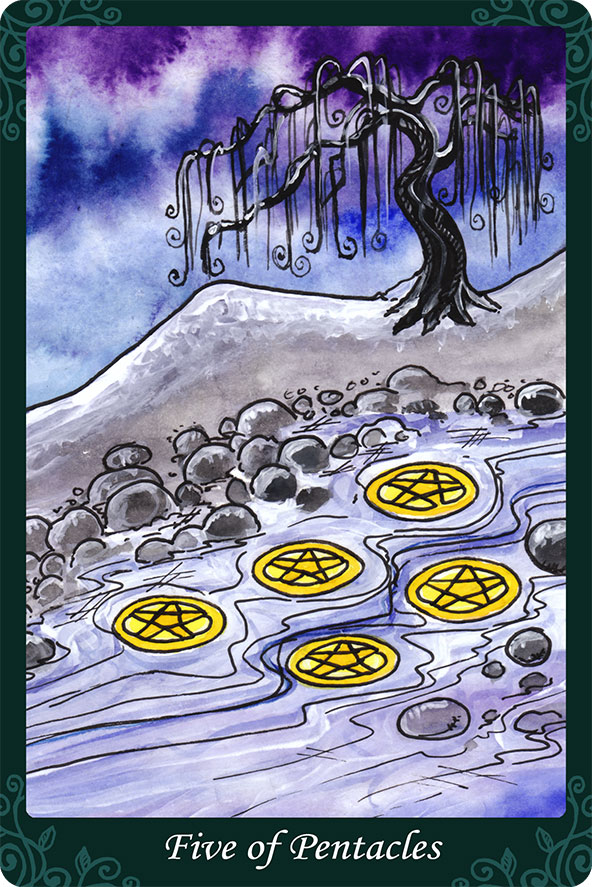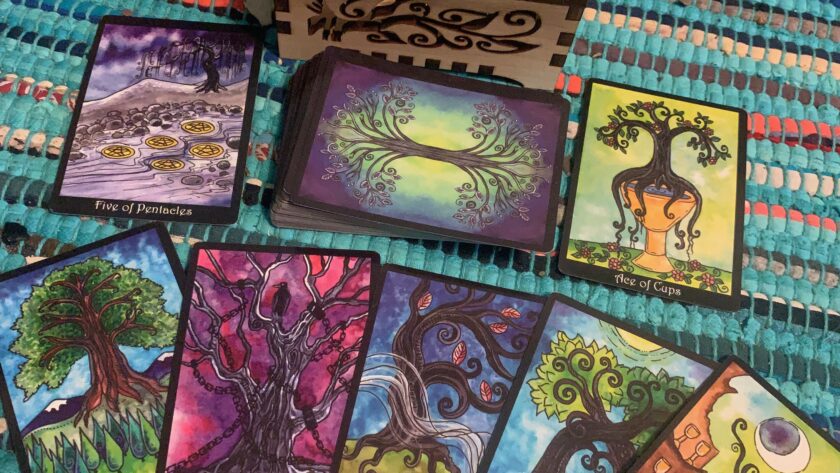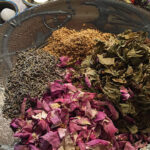 When people think of the Tarot, they often think of its primary use as a divination tool. Tarot is an incredibly versatile tool, and now you can get hundreds of decks on practically any theme, choose from dozens of books to help you learn, and access a wide variety of free online resources. Learning to read them as a divination method is as straightforward as picking up a book, drawing cards, and reading entries–and yet mastering them can take a lifetime.
When people think of the Tarot, they often think of its primary use as a divination tool. Tarot is an incredibly versatile tool, and now you can get hundreds of decks on practically any theme, choose from dozens of books to help you learn, and access a wide variety of free online resources. Learning to read them as a divination method is as straightforward as picking up a book, drawing cards, and reading entries–and yet mastering them can take a lifetime.
I wanted to share a few additional ways that I’ve used the Tarot over the years to enhance my spiritual practice. The Tarot has many uses beyond divination, and learning some of these can deepen your work with the Tarot even further. These methods can be tied directly to divination uses, help you learn the Tarot in a new way, or be used on their own. All images are from the 10th Anniversary Edition of the Tarot of Trees – if you haven’t yet checked out the new Indegogo campaign to preorder the new edition, please consider doing so!
Journeying with the Tarot
One of my favorite uses of the Tarot, and one that I think you can do with a wide variety of decks, is using the Tarot as a journeying tool. For example, if you gaze into The Fool card from the Tarot of Trees above, you can see how that card was intended to lead you on a journey. Imagine continuing to travel that path that the Fool is looking down upon. You can envision yourself going off into the distant mountains and seeing who you meet there. Perhaps you’d meet a higher self, other archetypes or individuals from the tarot, or other spirit guides. The entire Tarot can work this way–creating a rich and meaningful landscape where you can explore the world of spirit. Deep journeying techniques often use an aid to help you go deep into this world (what this world actually is is subject to interpretation: some believe it is the imaginal world, the world of your subconscious. Others believe that you are using your imagination to access and interpret something beyond you–a world of spirit. The practice works regardless of what you believe!)
A simple way of journeying is to open up a sacred space (see next entry for one idea) and then do deep breathing exercises to help put yourself in a receptive place so that you can focus on the journey at hand. Place the card in front of you, perhaps on an altar. Focus for a few moments on the card, noticing the different features of the card. Close your eyes and visualize the card before you (if you have trouble doing this, just open and close your eyes a few times till you can). Once you have the card firmly visualized in your mind’s eye, step into that scene, and see where spirit leads. You may meet new spirit guides, experience new places, and most importantly, have deep insights about yourself and your work in the world. I have a separate post on spirit journeying, and I will refer you there for more information on how to do this if you are new to it.
Finally, I will say that some decks and cards are better for journeying than others. Some have what I’d call “gateways” into the cards, where your eyes are naturally invited in. Certain simplistic themed decks may not work as well as more complex decks for this purpose, but every deck is worth a try.
Tarot and Holding Sacred Space
 This is a technique I developed when designing the Plant Spirit Oracle deck–I wanted to ritualize the use of the deck. Thus, I realized you can use any deck (oracle or Tarot) to open sacred space. In druidry and other neopagan traditions, we typically call the four directions/elements (OBOD) or seven directions/elements (AODA)–and while individual druids can modify these calls to the directions/elements as they see fit, we are always essentially drawing upon the same energy sources to open sacred space. While there is a benefit to doing so, as you develop deep relationships with those energies over time, it creates a static rather than dynamic system. What I mean is that you are always drawing upon those same energies.
This is a technique I developed when designing the Plant Spirit Oracle deck–I wanted to ritualize the use of the deck. Thus, I realized you can use any deck (oracle or Tarot) to open sacred space. In druidry and other neopagan traditions, we typically call the four directions/elements (OBOD) or seven directions/elements (AODA)–and while individual druids can modify these calls to the directions/elements as they see fit, we are always essentially drawing upon the same energy sources to open sacred space. While there is a benefit to doing so, as you develop deep relationships with those energies over time, it creates a static rather than dynamic system. What I mean is that you are always drawing upon those same energies.
Adding the element of a Tarot deck or Oracle deck creates a more dynamic calling, where you are essentially using the deck to create a dynamic map of energy that is spirit led. That is, rather than calling in the energy of earth, air, fire, and water, you can draw a card for each of the quarters and those cards would lend their own energy. In terms of the tarot, you can choose to do this with just the major arcana or use the entire deck. In essence, you go to each of the quarters, draw a card, and invite that energy to hold that quarter for you. I also have a post on this technique, so check it out for more details!
Tarot and Archetypes for Understanding, Meditation, and Reflection
 Another powerful way that the Tarot can be used is an extension of the Tarot as a divination tool. The first 22 cards of the Tarot are the Fool’s Journey. This is where the Fool (card 0) goes on a journey through the major arcana, meeting many different figures and having different experiences (Justice, Death, Strength, The Star, etc), and coming to a deep sense of realization and self-actualization during the experience (The World). These archetypes in the Major Arcana are closely aligned by those in use by other authors exploring self-development processes, notably, Carl Jung and Joseph Cambell. Jung’s work on archetypes and dreams, for example, helps us look deep within ourselves to see how common archetypes play out or manifest out of our subconscious. I find that you can do similar kinds of work using the Tarot as a focus.
Another powerful way that the Tarot can be used is an extension of the Tarot as a divination tool. The first 22 cards of the Tarot are the Fool’s Journey. This is where the Fool (card 0) goes on a journey through the major arcana, meeting many different figures and having different experiences (Justice, Death, Strength, The Star, etc), and coming to a deep sense of realization and self-actualization during the experience (The World). These archetypes in the Major Arcana are closely aligned by those in use by other authors exploring self-development processes, notably, Carl Jung and Joseph Cambell. Jung’s work on archetypes and dreams, for example, helps us look deep within ourselves to see how common archetypes play out or manifest out of our subconscious. I find that you can do similar kinds of work using the Tarot as a focus.
Draw a card from the major arcana (or the full deck if you prefer) and spend some time with that card. Consider using discursive meditation, freewriting, or other reflective techniques to think about the role of that archetype. For example, if I drew the Hermit and wanted to explore it, here are some of the questions I might consider: How does energy like the Hermit play into your life? In what ways have you felt that you need hermitage? In what was has hermitage benefited you? Do you have people who have filled this role or are you moving into this role? These kinds of reflections and meditations can be powerful and give you deeper insight into yourself. One of the ways that I originally learned Tarot was doing just this
Tarot and Bardic Inspiration
 If you practice any of the bardic arts (storytelling, poetry, music, dance, visual arts, etc) you might consider using one or more of the cards as inspiration for your work. For example, you can do a dance focused on the Queen of Cups and embodying her, or a poem dedicated to the three of wands. The reason that I ended up painting the Tarot of Trees those years ago was this exact inspiration–as I was learning tarot, I wanted to do my own inspirations. That ended up going in a direction I didn’t expect–painting and self-publishing my own tarot deck (and later, oracle deck!) But the original intention of my work was to explore these ideas as a bard, as a visual artist, and to really think about how I would translate them into the new theme. How could I translate, say, the brashness of the Knight of Wands into a tree? It was great fun–so let the awen flow and be inspired! It also allowed me to develop my own meanings and understandings for this work.
If you practice any of the bardic arts (storytelling, poetry, music, dance, visual arts, etc) you might consider using one or more of the cards as inspiration for your work. For example, you can do a dance focused on the Queen of Cups and embodying her, or a poem dedicated to the three of wands. The reason that I ended up painting the Tarot of Trees those years ago was this exact inspiration–as I was learning tarot, I wanted to do my own inspirations. That ended up going in a direction I didn’t expect–painting and self-publishing my own tarot deck (and later, oracle deck!) But the original intention of my work was to explore these ideas as a bard, as a visual artist, and to really think about how I would translate them into the new theme. How could I translate, say, the brashness of the Knight of Wands into a tree? It was great fun–so let the awen flow and be inspired! It also allowed me to develop my own meanings and understandings for this work.
Thus, thinking about how to use the Tarot as a catalyst for your own work could be a great avenue into new possibilities as a bardic practitioner. Perhaps you compose a series of poems around the major arcana or do a series of paintings. Perhaps you can create a dance, a story, or a song. You can even decide to create your own deck (I have a post about creating your own tarot or oracle deck if you are interested!)
Conclusion
Dear readers, I hope that these inspirations give you some new ideas for how to work with Tarot beyond divination meanings. If you have other ways that you use the Tarot, please share it in the comments.




Reblogged this on Paths I Walk.
Beautiful artwork.
Thank you, Paula! 🙂
Reblogged this on Good Witches Homestead.
What a nice deck you got. I really love the artwork…
Thank you! :).
I’ve never heard the term “Bardic arts” but I absolutely resonate with that!!! <3 This is great thank you for sharing!
Hi Exploring Insight! The bardic arts are a major part of the druid tradition, one of the three expressions or paths of druidry. I’m glad you resonate! 🙂